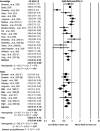Parental Monitoring and Its Associations With Adolescent Sexual Risk Behavior: A Meta-analysis
- PMID: 26620067
- PMCID: PMC5513153
- DOI: 10.1542/peds.2015-0305
Parental Monitoring and Its Associations With Adolescent Sexual Risk Behavior: A Meta-analysis
Abstract
Context: Increasingly, health care providers are using approaches targeting parents in an effort to improve adolescent sexual and reproductive health. Research is needed to elucidate areas in which providers can target adolescents and parents effectively. Parental monitoring offers one such opportunity, given consistent protective associations with adolescent sexual risk behavior. However, less is known about which components of monitoring are most effective and most suitable for provider-initiated family-based interventions.
Objective: We performed a meta-analysis to assess the magnitude of association between parental monitoring and adolescent sexual intercourse, condom use, and contraceptive use.
Data sources: We conducted searches of Medline, the Cumulative Index to Nursing and Allied Health Literature, PsycInfo, Cochrane, the Education Resources Information Center, Social Services Abstracts, Sociological Abstracts, Proquest, and Google Scholar.
Study selection: We selected studies published from 1984 to 2014 that were written in English, included adolescents, and examined relationships between parental monitoring and sexual behavior.
Data extraction: We extracted effect size data to calculate pooled odds ratios (ORs) by using a mixed-effects model.
Results: Higher overall monitoring (pooled OR, 0.74; 95% confidence interval [CI], 0.69-0.80), monitoring knowledge (pooled OR, 0.81; 95% CI, 0.73-0.90), and rule enforcement (pooled OR, 0.67; 95% CI, 0.59-0.75) were associated with delayed sexual intercourse. Higher overall monitoring (pooled OR, 1.12; 95% CI, 1.01-1.24) and monitoring knowledge (pooled OR, 1.14; 95% CI, 1.01-1.31) were associated with greater condom use. Finally, higher overall monitoring was associated with increased contraceptive use (pooled OR, 1.42; 95% CI, 1.09-1.86), as was monitoring knowledge (pooled OR, 2.27; 95% CI, 1.42-3.63).
Limitations: Effect sizes were not uniform across studies, and most studies were cross-sectional.
Conclusions: Provider-initiated family-based interventions focused on parental monitoring represent a novel mechanism for enhancing adolescent sexual and reproductive health.
Copyright © 2015 by the American Academy of Pediatrics.
Conflict of interest statement
Figures



References
-
- Centers for Disease Control and Prevention . Sexually Transmitted Disease Surveillance 2013. Atlanta, Georgia: US Department of Health and Human Services; 2014.
-
- Centers for Disease Control and Prevention . HIV Surveillance Report, 2012. Atlanta, Georgia: US Department of Health and Human Services; 2014.
-
- Kost K , Henshaw S . Teenage Pregnancies, Births and Abortions, 2008: National Trends by Age, Race and Ethnicity. New York, NY: Guttmacher Institute; 2012.
-
- McKay A , Barrett M . Trends in teen pregnancy rates from 1996–2006: a comparison of Canada, Sweden, U.S.A., and England/Wales. Can J Hum Sex. 2010;19(1–2):43–52
-
- Finer LB . Unintended pregnancy among U.S. adolescents: accounting for sexual activity. J Adolesc Health. 2010;47(3):312–314 - PubMed
Publication types
MeSH terms
Grants and funding
LinkOut - more resources
Full Text Sources
Other Literature Sources
Medical

